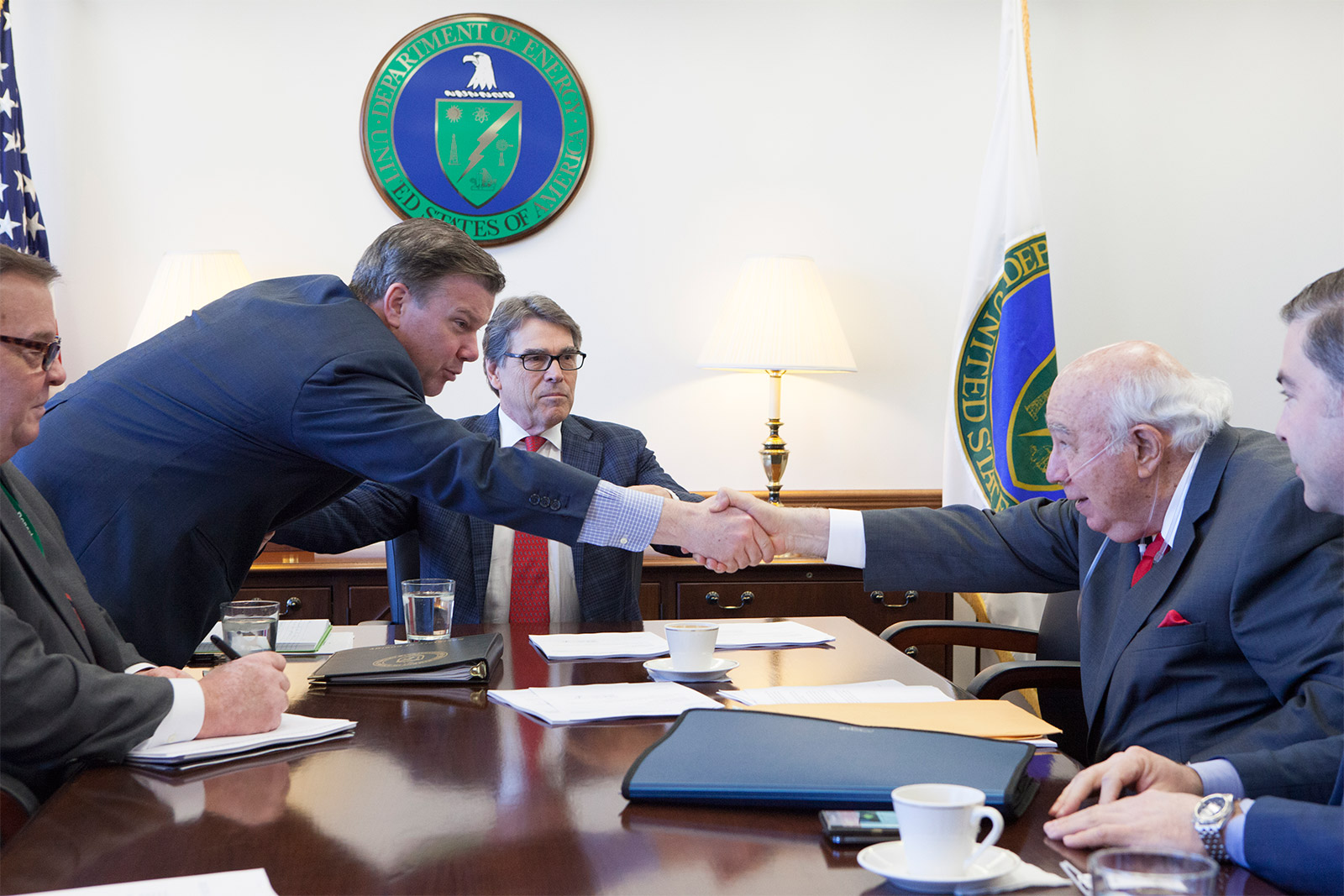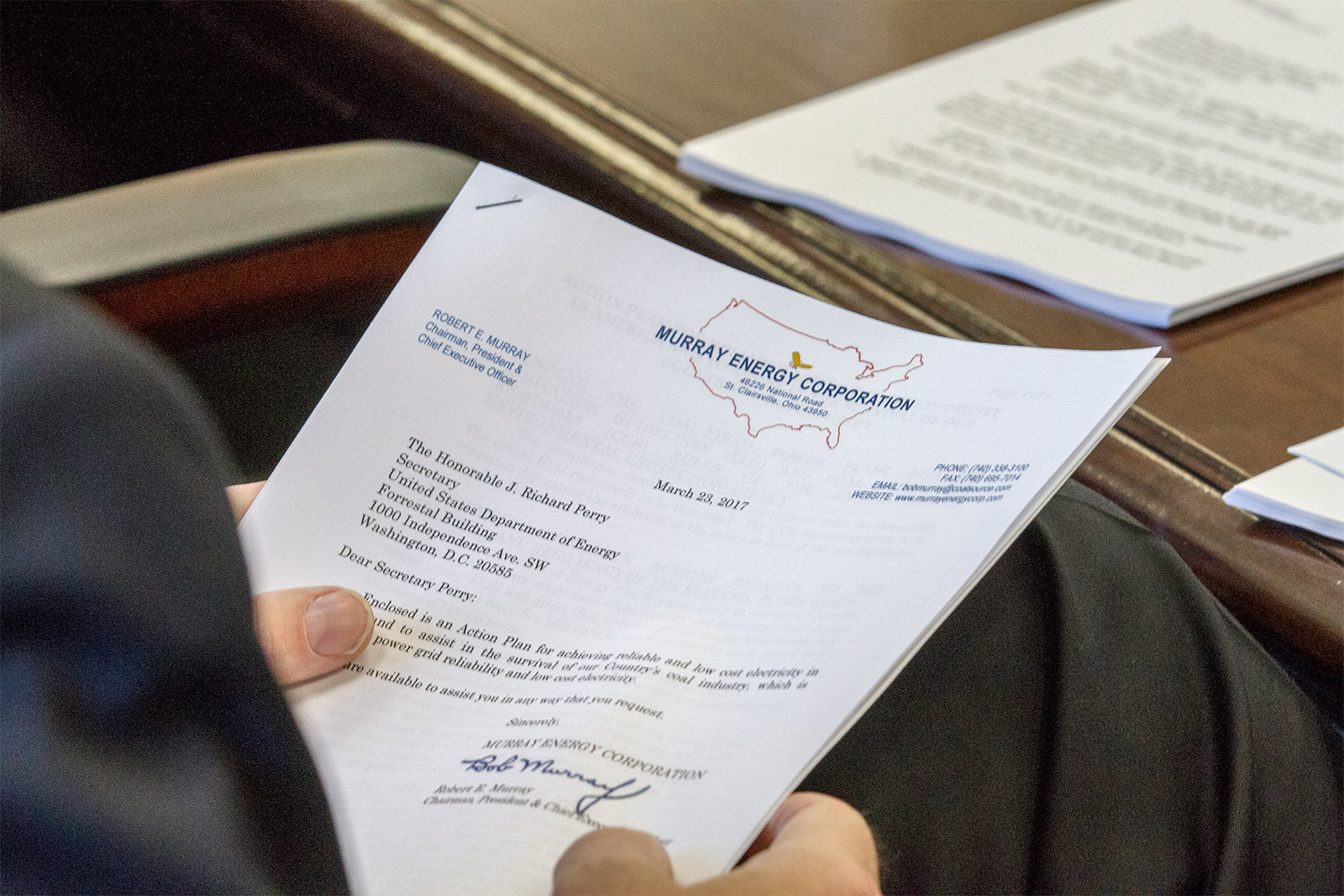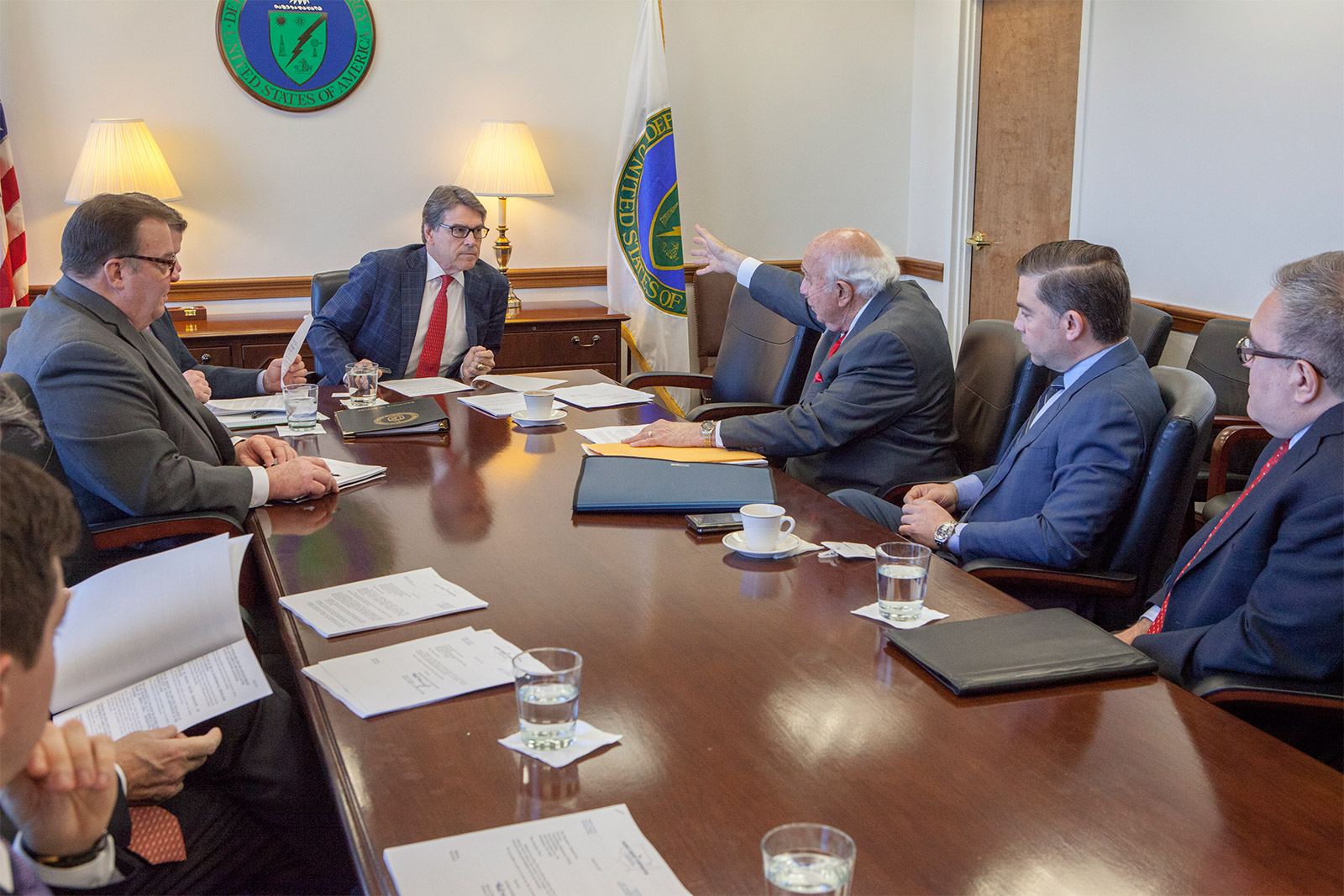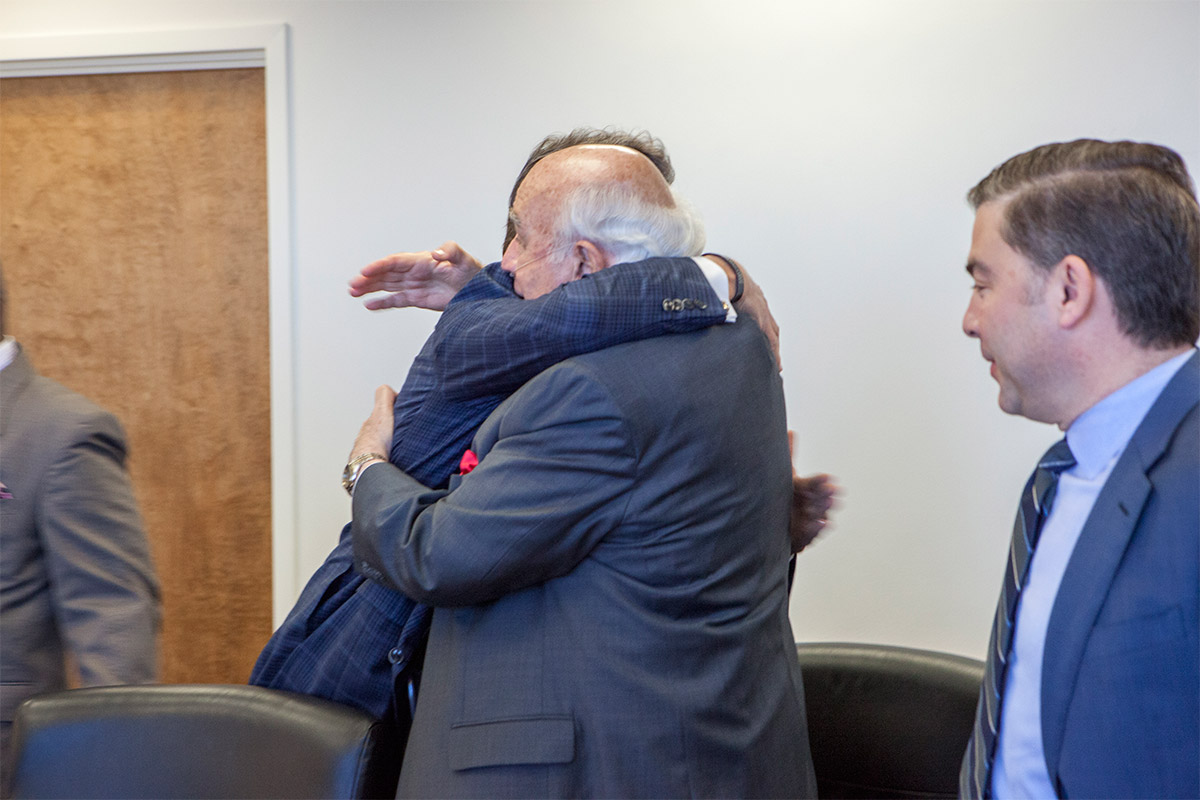
Exclusive Photos Contradict Murray Energy CEO’s Claim He Had “Nothing To Do with” Rick Perry’s Coal Bailout
At a previously undisclosed March 29 meeting, Robert Murray gave Perry a hug and a wishlist. Six months later, Perry unveiled a controversial plan that echoed one of Murray's proposals.
Above: At a March 29 meeting in Washington, D.C., Energy Secretary Rick Perry's chief of staff, Brian McCormack (L), shakes hands with Murray Energy CEO Robert Murray (R) as Perry (center) looks on.
December 6, 2017 | Investigative Report
UPDATE: Late Thursday, in advance of a Monday, December 11 deadline for action on Perry’s draft “grid resiliency” rule, the Federal Energy Regulatory Commission (FERC) requested 30 more days to decide on the rule. In a letter to Perry, newly sworn-in FERC chair Kevin McIntyre cited the commission’s two new members and the 1,500 comments it had received about the rule.
“I didn't have any involvement” in the drafting of a controversial new Department of Energy (DOE) rule subsidizing coal and nuclear plants, energy executive Robert Murray told Greenwire in late November. “This was done by the Trump administration. … I had nothing to do with it.”
In These Times has obtained photographs of a March 29 meeting between Murray and Energy Secretary Rick Perry that call this claim into question. The photographs show the Murray Energy CEO presenting a proposal to alter the policies of the Federal Energy Regulatory Commission (FERC) to favor coal plants, as a way to increase “grid reliability.”
The “Grid Resiliency Pricing Rule,” proposed by the DOE on September 28, echoes that suggestion. The rule amounts to a bailout for the coal and nuclear industries, premised on the controversial idea that, in the event of a natural disaster or extreme weather event, only coal and nuclear plants offer the fuel stores necessary to keep the grid running. The rule mandates that utilities pay those plants to operate even if they might otherwise be outcompeted and shut down. In effect, the rule could mean that electricity customers subsidize coal and nuclear companies to the tune of anywhere from $4 billion to over $10 billion a year. As Politico has reported, the rule disproportionately benefits Murray Energy, because it applies specifically to the Midwestern, Appalachian and Northeastern markets where Murray’s customer base is concentrated.

The cover letter of Murray Energy's "Action Plan," presented to Perry and other Department of Energy staff at the March 29 meeting. The plan outlines several sweeping changes that would benefit the coal industry.
The photographs capture a portion of the proposal advanced by Murray in the March meeting, which reads:
Immediate action needs to be taken to require organized power markets to value fuel security, fuel diversity, and ancillary services that only base load generating assets, especially coal plants, can provide.
“Require organized power markets to value fuel security” arguably translates to: Make sure that coal power generators get steadily paid, even if other forms of energy are cheaper. The text of Perry’s rule closely follows the logic of the Murray Energy proposal, although it replaces “base load generating assets, especially coal plants” with “generators with on-site fuel supplies,” and expands on the concept of “fuel security” by warning of “the severe consequences that additional shutdowns would have.” The DOE rule reads in part:
Immediate action is necessary to ensure fair compensation in order to stop the imminent loss of generators with on-site fuel supplies, and thereby preserve the benefits of generation diversity and avoid the severe consequences that additional shut-downs would have on the electric grid.
In a later section, the DOE rule also touts the benefits of coal over natural gas and other fuel sources.
The rule has come under widespread attack. Opposition from climate advocates is rooted in the fact that some two-thirds of existing coal, oil and gas reserves need to stay buried to avert catastrophic climate change. Of these three energy sources, coal is by far the most noxious. Burning all the fuel in developed coal reserves alone would see the planet sail past 1.5 degrees celsius of warming.

Perry listens intently to Murray at the March 29 meeting. Seated on the far right is Andrew Wheeler. Wheeler was a registered lobbyist with Murray Energy until August 11, and has been tapped by the Trump Administration to become Scott Pruitt's deputy administrator at the EPA.
Even the American Petroleum Institute—the lobbying arm of the oil and gas industry—has criticized the rule, on the grounds that it will discourage competition in the energy market. The API joined the Natural Gas Supply Association, the American Wind Energy Association and several other trade associations in filing a motion with FERC opposing Perry’s request.
Robert Murray, however, called the rule “the single greatest action that has been taken, in decades, to support low-cost, reliable electric power in the United States.”
The pictures obtained by In These Times document a small meeting in Washington, D.C., between Perry, Murray and their respective staffs on March 29, less than a month into Perry’s tenure as Energy Secretary. The photographs show Murray presenting a four-page “Action Plan For Reliable And Low Cost Electricity In America And To Assist In The Survival Of Our Country’s Coal Industry.” (See comment from Murray Energy at bottom.)
It’s been known since at least October that Murray Energy crafted an “action plan” for federal agencies to more systematically favor the coal industry, which has been circulated in the highest echelons of the Trump Administration. Murray has publicly boasted that the White House is hard at work implementing his company’s policy priorities across various government agencies.
The photographs appear to show, for the first time, some of the details of that action plan. In addition to the call for “grid reliability,” the document advocates replacing the current members of FERC and gutting the EPA. The photographs also suggest that Murray’s policy wishlist extends well beyond the action plan. Energy officials also received a thick packet of six draft executive orders to roll back the “anti-coal regulations of the Obama Administration.”
The meeting came a day after Trump signed an executive order pledging to repeal the Obama administration’s Clean Power Plan, which had been vehemently opposed by both Murray Energy and the API. Murray sat in the front row of the ceremony marking the occasion, and called the order “wonderful for America.”

Energy Secretary Rick Perry (L) and coal magnate Robert Murray (R) embrace. Perry's 2012 presidential campaign received more than $100,000 in Murray Energy donations, according to the Center for Responsive Politics.
Inside the Action Plan
The first mention of a Murray Energy action plan appears to be in a Frontline interview with Murray that aired in mid-October. Following the interview, Sen. Sheldon Whitehouse (D-R.I.) called for the plan’s release, but until now, no details of such an action plan have been made publicly available. The photographs obtained by In These Times capture sections of the document and indicate that its scope is vast. Bulleted items include proposals to replace members of the Tennessee Valley Authority board, FERC and the NLRB, which—the plan alleges—holds an “anti-employer bias.” The plan also advises cutting the staff of the EPA “in at least half.”
Another photograph shows a cover letter introducing the action plan, addressed to Perry, signed by Murray and printed on Murray Energy letterhead. It concludes, “We are available to assist you in any way that you request.”
The last page of the plan addresses FERC regulation of coal. “The current Federal Energy Regulatory Commission has a history of favoring actions of the Obama Administration,” it states. “That has systematically devalued base load generation as a result of the Obama ‘war on coal.’ Immediate action needs to be taken to require organized power markets to value fuel security ...”
The text amounts to a rough blueprint of the rule unveiled by Perry in September and expected to come to a vote in a FERC meeting on Monday, December 11. At Perry’s urging, FERC will decide whether to integrate the proposal into the country’s energy regulatory landscape.
On the premise that fuel storage will make the grid more reliable, the rule guarantees payments from utilities to power plants that store 90 days’ worth of fuel supplies onsite—which applies only to coal and nuclear facilities. Natural gas, coal’s main competitor, is brought onsite via pipelines so would not qualify. Nor would sources of solar and wind energy.
The rub is that without this guaranteed payment, many of these coal and nuclear plants might soon have been slated for closure, mostly thanks to competition with natural gas. That’s because, in a deregulated market, utilities rely on the most cost-effective option in deciding which power source ratepayers use and pay for. The DOE rule preempts that, essentially making ratepayers in a number of Midwestern, Appalachian and Northeastern states foot the bill for a bailout of ailing coal and nuclear plants. An analysis by the research firm ICF finds that the proposal could cost up to $4 billion a year. A separate study, from the non-profit group Energy Innovation, puts the figure as high as $10.6 billion annually, virtually all of which would be paid for by electricity customers in the areas covered by the DOE rule.
The rule covers about 40,000 of the nation’s 280,000 Megawatts of coal-fired power generating capacity, largely focusing on something called the PJM Interconnection, a regional electricity market containing several Midwest, Appalachian and Northeast states. Murray Energy provides a large portion of the coal for coal-fired generation within the PJM market, which contains one of its biggest customers, FirstEnergy. Politico found that FirstEnergy purchased around two-thirds of its fuel from Murray Energy in 2015, the most recent year for which data is available. Murray argued in a letter to the Department of Energy that the companies’ fates were tied, and both would go bankrupt without federal intervention to help FirstEnergy.
FirstEnergy has used a mechanism similar to Perry’s rule to keep troubled coal plants online in Appalachia. In 2013, the company transferred the coal-fired Harrison Power Station from a subsidiary in an unregulated energy market to West Virginia’s regulated energy market. The process, known as “re-regulation,” sticks utility customers with the bill for operating a plant they don’t need. An analysis from the Institute for Energy Economics and Financial Analysis (IEEFA) found that—as of September 2017—the transfer had cost West Virginian ratepayers upward of $160 million.
“The philosophy behind [the DOE rule] is the same,” says IEEFA energy analyst Cathy Kunkel. And though Perry has justified the rule on the basis of grid reliability, Kunkel, who co-authored the IEEFA study, says there are already policies in place through regional transmission networks to keep plants from closing in the event of an emergency.
Perry has used the Department of Energy’s own grid reliability study, published in August, to paint a dire picture of the nation’s energy stability. But the DOE study’s lead author, Alison Silverstein, told Forbes that the recommendations in Perry’s rule make it seem "as though they had never read [the study]." She downplayed Perry’s dire warnings about plant shutdowns and threats to reliability, and her own recommendations based on the report differ dramatically from the DOE’s.
The DOE rule would mean that “ratepayer dollars that are spent to bail out old plants are not being spent to develop more efficient forms of energy,” Kunkel says. “You would effectively be crowding out the grid of the future,” including investments in more resilient and cost-effective systems like microgrids. “If you’re serious about grid reliability in times of crisis, then develop microgrids,” she says. “Those are the only things that kept power on during Hurricane Sandy.” Unlike central station power generation, microgrids—often run on renewables—can continue operating even when utilities’ generation and transmission systems fail.
In late July and early August, Murray and FirstEnergy representatives proposed that the DOE stave off coal plant closures by invoking Section 202(c) of the Federal Power Act, intended to give the agency expanded authority in the event of a war, natural disaster or terrorist attack. Though that request was ultimately denied, the DOE rule would perform a similar service for FirstEnergy: extending a lifeline from the federal government to troubled generation sources at the expense of utility customers.
Wheeling and dealing
If enacted, the plan would be a coup for Murray, whose direct and indirect ties to the administration are well documented. Andrew Wheeler, a former lobbyist for Murray Energy tapped by Trump to serve as deputy administrator of the EPA, admitted during his Senate confirmation hearing that he had attended meetings on behalf of Murray with Perry and seen the action plan. Wheeler, who is pictured in the March meeting, denied involvement in the DOE rule’s creation. “I have not been involved in anything the last few months when this issue has been front and center,” he said. Wheeler said he attended on behalf of Murray.
Murray has heaped glowing praise on Trump, Perry and EPA administrator Scott Pruitt, who he calls a “star.” Speaking with Greenwire in October, he called the DOE rule proposal “the single greatest action that has been taken in decades to support low-cost reliable electric power in the United States.”
His endorsements of Trump and several senior administration officials have been financial, as well. The company poured $200,000 into Trump’s presidential campaign last year through its PAC, with Murray personally hosting a fundraising dinner. Wheeler told the Washington Post recently that that dinner, hosted in Wheeling, W.Va., is what won him over to Trump’s campaign.
Murray hosted a similar, $2,500-a-head fundraising reception for Perry in 2011 during his bid for the Republican presidential nomination. “We are having a reception and dinner for Presidential candidate Governor James Richard “Rick” Perry of Texas, who is likely to be the Republican Nominee to defeat the destructive Barack Obama,” a letter of invitation from Murray states. The invite went on to describe the 2012 race as the “likely most vital election for America in our lifetimes.”
“In summary,” Murray concludes, “Governor Rick Perry, a ‘Reagan Republican,’ will attempt to restore confidence in the American Dream and American Exceptionalism, and get the Country moving again.” In all, Perry received six figures in donations from Murray Energy and its employees during that race, according to the Center for Responsive Politics. Murray has come under legal fire and FEC investigation in the past for strong-arming his employees into making political contributions to the company’s conservative PAC. A 2012 memo from Murray, obtained as evidence in a lawsuit brought by one of his former employees, pressures managers into compelling salaried workers to attend a fundraising event for the chairs of the House Energy and Commerce and Natural Resources committees, the lower house bodies “with the greatest jurisdiction over coal.”
“What is so difficult about asking a well-paid, salaried employee to give us three (3) hours of his [or] her time every two months?” he asks, after bemoaning the preponderance of “empty chairs” at similar events. The email then lists several salaried employees whom Murray had not seen at recent fundraisers for coal-friendly politicians.
The parallels between the DOE language and Murray’s mirrors an incident that occurred while Scott Pruitt was serving as Oklahoma’s Attorney General, where he reliably went after the EPA. As the New York Times’ Eric Lipton revealed, Pruitt allowed Devon Energy to draft a complaint to the EPA on official Oklahoma AG letterhead. Where in that case language was taken verbatim from industry sources, the language in Perry’s rule is more general.
At this point, the remaining details on what else in the action plan have yet to emerge. One prize Murray and other fossil fuel industry interests have had their eye on is a scaleback of the so-called endangerment finding, the result of a 2007 Supreme Court ruling (Massachusetts v. EPA), which gives the EPA the authority and mandate to regulate carbon dioxide emissions, the leading contributor to human-made climate change.
Whether Trump administration regulators set their sites on the endangerment finding or not, what is clear is that the Trump administration is closely engaged in the business of picking winners and losers in America’s energy economy, and that at least one major campaign contributor in the extractive energy business has the administration's ear. 
UPDATE: Murray Energy did not meet the initial deadline for comment, but spokesperson Gary Broadbent sent the following after the story was posted:
Mr. Murray confirms that he met with Secretary Perry on March 29, 2017 in order to discuss the reforms necessary to protect jobs and livelihoods in the United States coal industry, including initiating a study of the reliability and resiliency of the electric power grid. Ultimately, the Department of Energy did conduct a study. During the meeting, Mr. Murray never discussed the “Grid Resiliency Pricing Rule,” which has been proposed under Section 403 of the Department of Energy Organization Act, as he has stated heretofore. Indeed, he had no prior notice of this rulemaking and was not involved in drafting the rule.
UPDATE: The company first sent a version of the comment above stating that Murray had "invok[ed] Section 202(c) of the Federal Power Act to prevent the closure of coal-fired power plants" at the March 29 meeting. Broadbent emailed several hours later to say that 202(c) had not come up in the meeting. The comment has been updated.
is a writing fellow at In These Times covering the politics of climate change, the White House transition and the resistance to Trump's agenda. Follow her on Twitter @katearonoff.
Want to stay up to date with the latest political news and breaking investigations? Subscribe to the free In These Times weekly newsletter:
